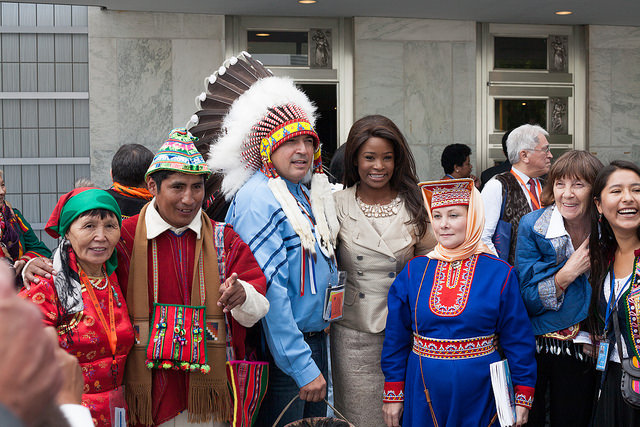
Credit: UN Photo/Yubi Hoffmann
On September 22 and 23, the World Conference on Indigenous Peoples is taking place at the United Nations Headquarters in New York City. The purpose of the World Conference is to “share perspectives and best practices on the realization of the rights of indigenous peoples” and to pursue the objectives of the United Nations Declaration on the Rights of Indigenous Peoples. See UN General Assembly, Resolution 65/198, Indigenous Issues, UN Doc. A/RES/65/198, 21 December 2010, para. 8. The World Conference was convened as a high-level plenary meeting of the UN General Assembly’s 69th Session, and has resulted in the adoption of an “action-oriented” Outcome Document, which focuses on implementing indigenous rights. [UN News Centre]
Background
Thousands of individuals, indigenous and non-indigenous, are attending the World Conference, which focuses on protecting the rights of the 370 million indigenous peoples throughout the world. [UN News Centre] The UN General Assembly passed a resolution in 2010 to create the World Conference, as a means to reaffirm the UN’s commitment to realizing the rights of indigenous peoples and to fostering an open dialogue among Member States, representatives of indigenous populations, and others. See UN General Assembly, Resolution 65/198, Indigenous Issues, 21 December 2010, para. 8.
The World Conference will include opening and closing plenary sessions, multiple round-table discussions, and one interactive panel. [UN] The discussions will cover: UN action for the implementation of indigenous peoples’ rights; implementing indigenous rights on the local and national level; indigenous peoples’ lands, territories, and resources; and indigenous priorities for the post-2015 sustainable development agenda. [UN]
UN Member States, UN representatives and observers, indigenous peoples, civil society organizations, and national human rights institutions will all be participating in the discussions. [UN] The meetings will be co-chaired by indigenous representatives from regions throughout the world. [UN News Centre]
In addition to the official sessions, there will be multiple related side events, which began on September 19 and will continue through September 26.
The Outcome Document
The Outcome Document was drafted prior to the World Conference, through the joint efforts of Member States and indigenous peoples. See UN General Assembly, Outcome Document of the High-level Plenary Meeting of the General Assembly known as the World Conference on Indigenous Peoples, UN Doc. A/69/L.1*, 15 September 2014. It was adopted during the World Conference’s opening ceremony. [UN Press Release] Ban Ki-Moon, the United Nations Secretary General, praised the Outcome Document for containing “action-oriented commitments to bridge the gap between promises and results” concerning the implementation of indigenous rights. [UN Web TV at 7 minutes] He expressed his support for various provisions within the Outcome Document, including the recommendation that his office develop concrete proposals to enable indigenous populations to directly participate in UN activities, which he found to be critical for indigenous communities and for the work of the UN. [UN Web TV]
Framework of Indigenous Peoples’ Human Rights
The principal international framework for protecting and promoting indigenous peoples’ human rights is the UN Declaration on the Rights of Indigenous Peoples. The Declaration sets forth multiple rights that indigenous peoples possess, and also represents the UN Member States’ commitment to cooperate with indigenous peoples in good faith, and to obtain their “free, prior and informed consent before implementing legislative or administrative measures that may affect them.” See UN Declaration on the Rights of Indigenous Peoples, art. 32; UN General Assembly, Outcome Document of the High-level Plenary Meeting of the General Assembly known as the World Conference on Indigenous Peoples, 15 September 2014, para. 3.
Declarations are considered “non-binding” legal instruments, which means that Member States do not have a legally binding obligation to abide by the Declaration’s provisions under international law. [IJRC] However, declarations still have influence, and the Declaration on the Rights of Indigenous Peoples “represents a global consensus and has galvanize[d] international attention” on the rights of indigenous peoples. [UN News Centre] The World Conference has taken that attention one step further, and the hope is that the Outcome Document will provide Member States with additional guidance to effectively protect indigenous rights. [UN News Centre]
Several UN mechanisms promote and monitor the human rights of indigenous peoples. The UN Human Rights Council oversees the Special Rapporteur on the Rights of Indigenous Peoples, who advocates for the protection and promotion of indigenous peoples’ human rights throughout the world by conducting country visits, receiving information and complaints concerning human rights violations, and submitting annual reports to the UN Human Rights Council and UN General Assembly. The Human Rights Council has also created the Expert Mechanism on the Rights of Indigenous Peoples, which submits studies and advice to the Council regarding the rights of indigenous peoples. Additionally, the Permanent Forum on Indigenous Issues is an advisory body to the UN Economic and Social Council (ECOSOC), and is entrusted with discussing issues related to the economic and social development of indigenous peoples.
Regional human rights bodies also have similar special mechanisms, including the Inter-American Commission on Human Rights’ Rapporteurship on the Rights of Indigenous Peoples, and the Working Group on Indigenous Populations/ Communities in Africa, which operates under the African Commission on Human and Peoples’ Rights.
Additional Information
Video excerpts from the World Conference on Indigenous Peoples are available on UN Web TV. The full agenda is available on the World Conference’s website.
For additional information on the role of the UN Special Rapporteur on the Rights of Indigenous Peoples, see IJRC’s Online Resource Hub.
